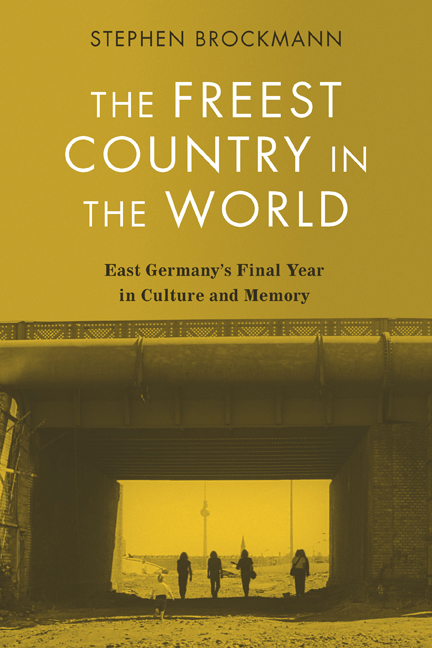Book contents
- Frontmatter
- Dedication
- Contents
- Acknowledgments
- Introduction: The Memory of Freedom
- 1 Protocols of History: Reunification Documentaries from 1989/1990
- 2 Anarchy in the GDR
- 3 The National Liberation Zone
- 4 Coming of Age as the State Dies: Three Novels and Their Heroes
- 5 Provincial Theater: Fiction Film Struggles to Address German Reunification in the Early 1990s
- 6 The Grand Theater of the East and the Imaginary Stasi: The Emergence of the Standard Depiction of German Reunification in Film and on Television
- 7 Ritual, Repetition, and Memory: Commemorating and Memorializing 1989/1990
- Conclusion: The Last GDR
- Selected Works Cited
- Filmography
- Index
Introduction: The Memory of Freedom
Published online by Cambridge University Press: 11 January 2024
- Frontmatter
- Dedication
- Contents
- Acknowledgments
- Introduction: The Memory of Freedom
- 1 Protocols of History: Reunification Documentaries from 1989/1990
- 2 Anarchy in the GDR
- 3 The National Liberation Zone
- 4 Coming of Age as the State Dies: Three Novels and Their Heroes
- 5 Provincial Theater: Fiction Film Struggles to Address German Reunification in the Early 1990s
- 6 The Grand Theater of the East and the Imaginary Stasi: The Emergence of the Standard Depiction of German Reunification in Film and on Television
- 7 Ritual, Repetition, and Memory: Commemorating and Memorializing 1989/1990
- Conclusion: The Last GDR
- Selected Works Cited
- Filmography
- Index
Summary
MY GOAL IN THIS BOOK is to explore a brief period of time in the German Democratic Republic (GDR) and reunified Germany—1989 to 1990—as well as the subsequent cultural memory of that brief era. This period witnessed the GDR's collapse in 1989 and Germany's reunification in 1990. It began slowly, with seeming normality. Most people assumed that the GDR would probably last for the foreseeable future and continue more or less as before.
As late as June of 1989, less than half a year before the Berlin Wall fell, the West German writer Peter Schneider, a respected expert on German matters and the author of a well-known novel about Berlin's division, Der Mauerspringer (The Wall Jumper, 1982), opined in the pages of the New York Times Magazine that the Wall was likely to remain for the foreseeable future, and that the thought of German reunification was unrealistic: “there is no ‘human right’ of German reunification and there will continue to be two German states.” At the time Schneider's reflections represented the consensus of mainstream opinion on what was known as the “German question.”
Although it began slowly and with seeming normality, the 1989– 1990 period ended rapidly, with a series of radical changes that completely transformed the lives of East Germans. These changes included but were not limited to the end of the socialist economy, the introduction of western currency, the sudden threat—and reality—of unemployment, free and fair elections, the reconstitution of the former eastern Länder (states) Thuringia, Saxony, Saxony-Anhalt, Mecklenburg-Western Pomerania, and Brandenburg (which had been eliminated in the GDR decades earlier in order to enable a higher degree of central government control), and ultimately official national reunification on October 3, 1990, less than a year after the previously unimaginable opening of the Berlin Wall on November 9, 1989.
The most common response at the time of the Wall's opening was “Wahnsinn” (insanity). The word expressed just how unimaginable such an event had previously seemed. What happened in East Germany in 1989 was not supposed to be on the cards. As the philosopher Jürgen Habermas later described it, these events surprised even a West German government whose publicly stated goal was ultimate national reunification. They caught the Federal Republic “with its pants down.”
- Type
- Chapter
- Information
- The Freest Country in the WorldEast Germany's Final Year in Culture and Memory, pp. 1 - 30Publisher: Boydell & BrewerPrint publication year: 2023



